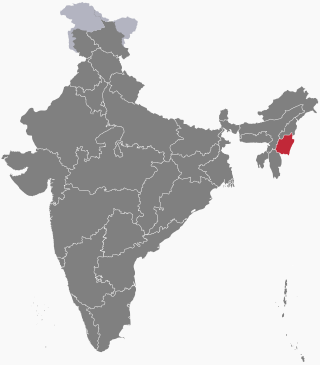Related Research Articles

Meitei, also known as Manipuri, is a Tibeto-Burman language of northeast India. It is spoken by around 1.8 million people, predominantly in the state of Manipur, but also by smaller communities in the rest of the country and in parts of neighbouring Myanmar and Bangladesh. It is native to the Meitei people, and within Manipur it serves as an official language and a lingua franca. It was used as a court language in the historic Manipur Kingdom and is presently included among the 22 scheduled languages of India.

The Manipuri Dance, also referred to as the ManipuriRaas Leela, is one of the eight major Indian classical dance forms, originating from the state of Manipur. The dance form is imbued with the devotional themes of Madhura Raas of Radha-Krishna and characterised by gentle eyes and soft peaceful body movements. The facial expressions are peaceful mostly expressing Bhakti Rasa or the emotion of devotion, no matter if a dancer is Hindu or not. The dance form is based on Hindu scriptures of Vaishnavism and is exclusively attached to the worship of Radha and Krishna. It is a portrayal of the dance of divine love of Lord Krishna with goddess Radha and the cowherd damsels of Vrindavan, famously known as the Raas Leela.
Shantidas Adhikari, popularly known as Shantidas Gosai or Shantidas Goswami, was a Hindu preacher from Sylhet who converted King Pamheiba of Manipur from traditional Meitei religion to Hinduism in 1717 C.E.

Chinglen Nongdrenkhomba (1788–1834), also known as Raja Gambhir Singh, was a ruler of the Manipur Kingdom.

Meitei literature, also known as Manipuri literature, is literature written in the Meitei language of Manipur. An ancient institution of learning, the Luwang Nonghumsang, later known as the Pandit Loishang, collected sources of indigenous Meitei knowledge and philosophy until the 18th century. Writing by Meiteis is assumed to go back to the Kingdom of Kangleipak in the early 12th century. The Meitei script is a Brahmic abugida. It is known only from the Puya manuscripts discovered in the first half of the 20th century. 18th and 19th century manuscripts were written using the Bengali alphabet. The existence of the Meitei script in the 15th-century hinges on the authenticity of an inscription dated to the reign of Senbi Kiyamba. The first printed Manipuri book, Manipurer Itihas, appeared in 1890 from the Baptist Mission Press, Calcutta. Though the kings of Manipur had established contact with the British from the middle of the eighteenth century onward the real impact of the contact came much later. Johnstone Middle English School, based on the western system of education, was started in 1885 at Imphal, and in 1891 Manipur lost its independence to the British. British domination facilitated the introduction of new systems in the civil, political and educational spheres, which hastened the process of modernization in Manipur, exposed as it was to new ideas and influences

Leimarel Sidabi or Leimalel Sitapi is a goddess in Meitei mythology and the religion of Ancient Kangleipak. She is the highest female divinity in the Meitei pantheon. She is the goddess of earth, of nature and the household. She is revered as the mother of every living being in the universe.

Panthoibi is a goddess associated with civilization, courage, fertility, handicraft, love, victory, warfare and wisdom in the mythology and religion of Ancient Kangleipak. She is a consort of the God Nongpok Ningthou. She is considered to be one of the divine incarnations of Leimarel Sidabi and is also identified as a form of Goddess Nongthang Leima. She is worshipped mainly by the Meitei people in Manipur, Assam, Tripura, Bangladesh and Myanmar.

Nongshaba, also spelled as Nongsaba, is a Lion God in Meitei religion (Sanamahism) and mythology. He is also regarded as a king of the gods. He is credited with producing light in the primordial universe and is regarded as the maker of the sun. He is worshipped by the people of both the Ningthouja clans as well as the Moirang clans. God Nongshaba was worshipped by the people of Moirang clan as a lineage deity and regarded as the father of God Thangching (Thangjing). He is the greatest of the Umang Lais in Ancient Kangleipak but he made his only son Thangching (Thangjing) the chief deity of Moirang.

Leima Lainaotabi or Leinaotabi is a goddess in ancient Meitei mythology and religion. She is the youngest wife of God Thongalel of the underworld kingdom. Thongalel sent her to be the wife of Poireiton, her brother-in-law. Lainaotabi gave birth to a son with Poireiton. Her legend says she made the first clay pot. She was worshipped by the people of Ashangbam clan.

Pureiromba is a God in Meitei mythology and religion. He is the giver of rain and agricultural prosperity. He is one of the major Umang Lai deities. He is the Ancestor God of the Angom clan of the Meitei ethnicity.

Panam Ningthou is a God in Meitei mythology and religion. He is the protector of crops, especially paddy from hailstorm and thunder. According to legends, He ignited fire for the first time by rubbing flints. He is one of the Umang Lai deities.

Meitei mythology or Manipuri mythology is a collection of myths, belonging to the religious and cultural traditions of the Meitei people, the predominant ethnic group of Manipur. It is associated with traditional Meitei religion (Sanamahism). Meitei myths are a part of Meitei culture and explain various natural phenomena, how the human civilization developed, and the reasons of many things happening. Most of the Meitei legends are found in the Meitei language texts.

Phou Ningthou is a deity in Meitei mythology and religion (Sanamahism) of Ancient Kangleipak. He is the God and the divine male personification of the agriculture, crops, fertility, grains, harvesting, paddy, rice and wealth. He is the consort of Phouoibi (Phouleima), the goddess of crops and agricultural fertility.

The ancient legend of Khuyol Haoba and Yaithing Konu is one of the epic cycles of incarnations of Meitei mythology and folklore, that is originated from Moirang kingdom of Ancient Kangleipak. It concerns the fateful love of Khuyol Haoba, an orphan man, for the beautiful Yaithing Konu. Khuyol Haoba was the son of late Khundouremba, a court official of Moirang. Yaithing Konu was the daughter of Luwang Huiningsumba, an influential nobleman of Moirang.

"Chingkhong Poireiton", also known as "Poileiton", is a prince of the Khamnung and a younger brother of Thongaren, the god of death in Meitei mythology and religion. He is best known as a cultural hero, for leading a colonial immigration to the human world, as per the wish of his brother. He is mentioned in the Poireiton Khunthok, an ancient book about his immigration to the human kingdom.

"Poireiton Khunthok" or "Poireiton Khunthokpa" is an ancient Meitei literary narrative work (puya), describing about the immigration of a band of colonies, led by a man, Poireiton, the prince and younger brother of Thongaren, the god of the underworld kingdom, in the plains of the Kangleipak kingdom.

Meidingu Ura Konthouba or Wura Konthouba was a Meetei ruler of Ningthouja dynasty of Ancient Manipur. He is the successor of Sameirang and the predecessor of Naothingkhong. In 568 AD, he issued coins for the first time in the kingdom. During his reign, the Selloi Langmai tribes attacked the Haokap hills by trespassing the Meitei territory. The Naothingkhong Phambal Kaba describes that he uprooted the Selloi-Langmai people. His daughter was married to the King of Moirang whose descendants took the surname "Ura".
Pengsiba or Pengshiba was a ruler of ancient Manipur. He was a successor of Khui Ningomba and the predecessor of Kaokhangba. In the 4th century AD, during the reign of his era, Manipuri traders reached out on horseback to upper Burma and China. He is one of the nine kings who are associated with the design of a historic flag.
Khuyoi Tompok was a Meetei ruler of Ningthouja dynasty of Ancient Manipur. He is the only son and the successor of Emperor Nongda Lairen Pakhangba and Empress Laisana.
References
- 1 2 Tensuba, Keerti Chand (1993). Genesis of Indian Tribes: An Approach to the History of Meiteis and Thais. Inter-India Publications. ISBN 978-81-210-0308-7.
- 1 2 Anvīkshā. Jadavpur University. 2004.
- ↑ Sanajaoba, Naorem (1988). Manipur, Past and Present: The Heritage and Ordeals of a Civilization. Mittal Publications. ISBN 978-81-7099-853-2.
- ↑ Singh, R. K. Jhalajit (1992). A Short History of Manipur. R.K. Jhalajit Singh.